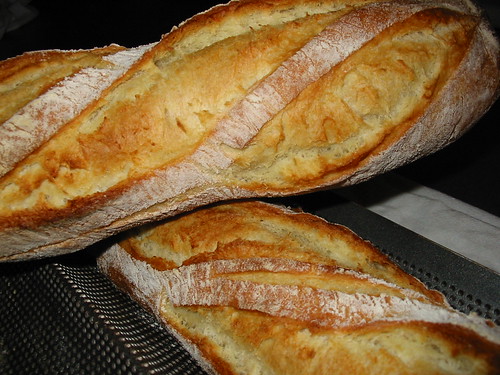
Kneadless process, olive oil, 2% w/w (20 g/kg dough).
Couple big changes to the baguette thing lately making the bread approximately the same crustiness, equivalent flavor and much less difficult. My time-tested baguette process is being rapidly replaced.
My aspiration is to make a quick video of it. But, for now, words.
The recipe for two one pounders:
1. Add to mixing bowl in this order:
water (room temp), 1 2/3 C (400 mL)
rapid rise packet of yeast
olive oil, 1T (ca. 15 grams)
salt, 2 t (10 grams)
swirl bowl
unbleached white flour, 4 1/4 C, not packed, loose, level
2. Mix with wooden spoon until it balls up.
3. Cover bowl containing shaggy mess with towel (don't let it touch sticky dough) and let rise for about 1-1.5 hours. If you use warm water, the mass will puff up rapidly.
4. Preheat the oven to 450-deg-F.
5. Flour the puffy mass generously with flour.
6. Punch down and gather the dough ball, divide in two pieces and "round it" as previously described.
7. Let rest in a ball for 10 minutes (no need to cover for this short a period).
8. Form into a baguette shape, again, as described in the original procedure.
9. Allow the baguettes to proof on the counter top dusted with flour and covered with a dish towel. No problem if the towel touches the surface, let proof for about 12-15 minutes.
10. Take the risen loaf and gently put it on the baguette pan. I use an 8" spackle knife in the kitchen and use this to gently lift the loaf with another spatula so I don't deflate it en route.
11. Dust top of loaves with flour again and slash vents in the top. Use a razor sharp knife (serrated or smooth) and cut FAST so you don't tear the loaf (this takes practice and is critical).
12. Place the pan in the lower third of the oven and close the door.
13. Open the door and toss a ca. 1/2 C of water on the floor of the oven to create a lasting plume of steam.
14. Cook until loaves are amber colored. Color is a perfect endpoint. Approximately 20 minutes. Let cool 10 minutes or so and cut in.
Enjoy.
12.12.2007
Kneadless baguette with a trace of olive oil
Subscribe to:
Post Comments (Atom)





2 comments:
OK, I've been making and re-making trying to get this right. Our flour seems unusually dry where I live - the mix isn't anywhere close to 'shaggy'. Anyway, my main question is that my baguette pan does NOT have holes in it. Your comments on this and what I could do to adjust? (prefer not to buy new pans, if possible)
Thanks
I have not done the experiment of using the pan that does not have the holes. But, when I use clay tiles, I don't get near the same volume and the loaves just aren't that good. I'm not trying to sell the pan, but I believe the perforations are part of the reason for the great oven spring and resulting crackly crust. The perforations permit the steam to bathe the entire exterior of the bread. Email me dave@davesbeer.com if you want to discuss any other questions (or post 'em here).
Post a Comment